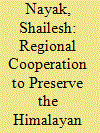|
|
|
Sort Order |
|
|
|
Items / Page
|
|
|
|
|
|
|
| Srl | Item |
| 1 |
ID:
165270


|
|
|
|
|
| Summary/Abstract |
The development of a country is closely linked to investments made in science and technology as well as in social science and humanities. The investments made by China during last three decades in scientific research and technological innovation have led to flourishing industries and ultimately to economic development. India needs to enhance its investment in scientific research and innovation. However, unregulated development also leads to environmental and ecological issues. India and China are both actively addressing issues related to climate change. It may be worthwhile to develop a joint strategy by India and China to mitigate impacts of climate change. Another area where India and China can work together to understand the Himalayan eco-system as it affects many countries in this region. A formation of the Himalayan Science Council has been proposed to address issues related to glaciology, biodiversity, earthquakes and landslide as well as social and cultural issues. Such collaboration can be further advanced in the Arctic and Antarctica through the Asian Forum for Polar Sciences and influence Arctic and Antarctic research. The scientific leadership which India has in the Indian Ocean needs to leveraged for scientific diplomacy with China. Such scientific collaboration will not only help India and China but also contribute towards addressing regional and global scientific challenges.
|
|
|
|
|
|
|
|
|
|
|
|
|
|
|
|
| 2 |
ID:
193593


|
|
|
|
|
| Summary/Abstract |
The Himalaya is a unique ecological system and millions of people depend on its rivers for water, food and energy. It has distinctive biodiversity with a variety of high altitude vascular plants, grasslands, birds, etc. The Himalaya is under stress due to natural hazards such as earthquakes, landslides, floods, glacial lake outburst floods, climate change impacts such as the retreat of glaciers, and changes in precipitation patterns. Besides, anthropogenic activities related to infrastructure development, urbanisation, tourism, etc., also affect the Himalayan system. Defencerelated activities by China, Pakistan and India have placed additional pressure on the Himalayan ecology. The geological, cryospheric, hydrological and atmospheric processes and their interaction need to be modeled for the preservation of the Himalayan ecosystem. The formation of the Himalayan Science Council (HSC) is a positive step but it needs to set up monitoring systems for observing/measuring geological, hydrological, cryospheric, atmospheric and biological phenomena. Collaboration between research institutes of the Himalayan nations is a critical necessit
|
|
|
|
|
|
|
|
|
|
|
|
|
|
|
|
|
|
|
|
|